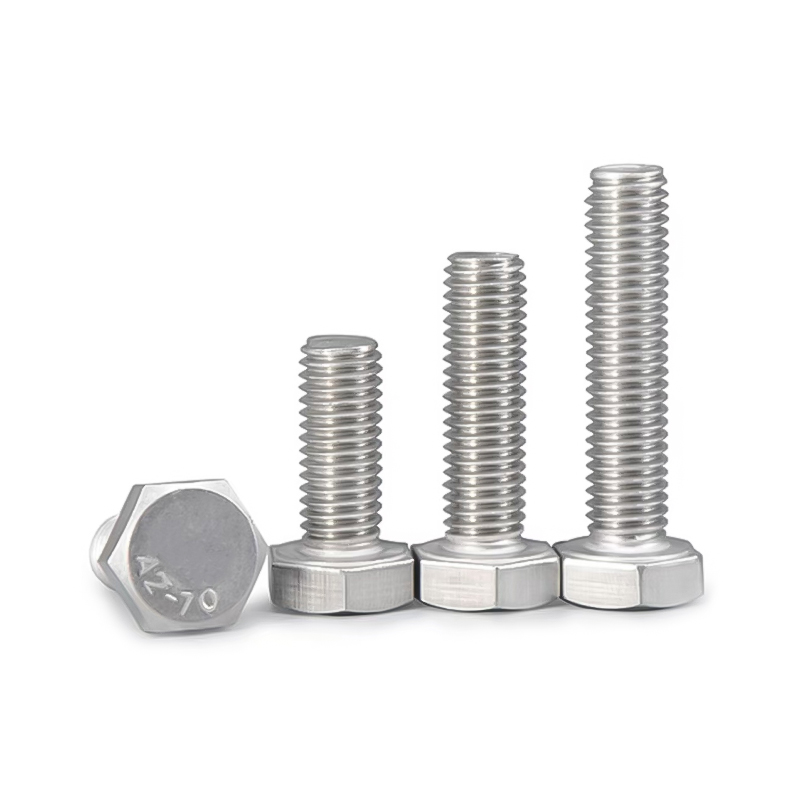Stainless steel screws are indispensable in applications ranging from aerospace and medical devices to marine infrastructure and consumer electronics, valued for their corrosion resistance, mechanical strength, and aesthetic appeal. However, the design and production of these fasteners involve intricate trade-offs between material properties, manufacturing precision, and environmental adaptability. What advancements in metallurgy, surface engineering, and quality control are critical to overcoming the limitations of stainless steel screws in extreme operational conditions?
1. Alloy Selection and Microstructural Optimization for Targeted Applications
Stainless steel screws are manufactured from austenitic (e.g., 304, 316), martensitic (e.g., 410, 420), or precipitation-hardening (e.g., 17-4 PH) grades, each tailored to specific performance criteria. Austenitic grades dominate general-purpose applications due to their excellent corrosion resistance and formability, while martensitic and precipitation-hardened grades are preferred for high-strength, wear-resistant scenarios.
Grade 316L: With 2–3% molybdenum and low carbon content, it resists pitting in chloride-rich environments (e.g., offshore platforms).
Custom alloys: Nitrogen-strengthened austenitic steels (e.g., 316LN) enhance yield strength without sacrificing corrosion resistance, ideal for cryogenic or high-pressure systems.
Microstructural control: Austenitic screws require precise annealing to prevent sensitization (chromium carbide precipitation at grain boundaries), while martensitic grades demand tempering to balance hardness and toughness.
The challenge lies in aligning alloy composition with end-use stresses. For instance, medical-grade screws (ASTM F138) must avoid nickel leaching in biocompatible applications, necessitating advanced refining techniques to minimize impurities.
2. Precision Manufacturing: Cold Heading, Thread Rolling, and Surface Finishing
The production of stainless steel screws involves high-precision cold heading and thread rolling to achieve dimensional accuracy and superior mechanical properties.
Cold heading: This process shapes wire stock into screw blanks using dies at room temperature. Stainless steel’s high work-hardening rate necessitates specialized tooling (tungsten carbide dies) and lubricants to prevent cracking. Multi-stage heading is often required for complex geometries like socket heads or self-tapping designs.
Thread rolling: Unlike cutting, rolling displaces material to form threads, enhancing fatigue resistance by up to 30% through compressive residual stresses. However, stainless steel’s hardness (e.g., 200–300 HV for 304) demands high-pressure rollers and alignment precision to avoid galling or thread deformation.
Surface treatments: Electropolishing removes microburrs and improves corrosion resistance, while passivation (nitric acid immersion) restores the chromium oxide layer post-machining. Coatings like TiN (titanium nitride) or DLC (diamond-like carbon) reduce friction and wear in high-cycle applications.
3. Corrosion and Wear Resistance: Addressing Localized Degradation Mechanisms
Despite stainless steel’s inherent corrosion resistance, screws remain vulnerable to:
Crevice corrosion: Occurs in oxygen-depleted gaps between the screw and substrate, common in marine or chemical processing environments. Solutions include using duplex stainless steels (e.g., 2205) with higher chromium and molybdenum content.
Galvanic corrosion: Arises when stainless steel screws contact dissimilar metals (e.g., aluminum). Insulating coatings (e.g., PTFE) or compatible material pairings (e.g., titanium) mitigate this risk.
Fretting wear: Micro-motion between threads under vibration degrades protective oxide layers. Shot peening or lubricant-impregnated coatings (e.g., MoS₂) reduce surface friction and wear.
4. Mechanical Performance: Torque-Tension Relationships and Fatigue Life
The functional integrity of a screw depends on its ability to maintain clamping force under dynamic loads. Key factors include:
Thread design: Fine threads (e.g., M4x0.5) offer higher tensile strength but require precise torque control to avoid stripping. Asymmetric thread profiles (e.g., Buttress threads) optimize load distribution in unidirectional applications.
Preload accuracy: Stainless steel’s lower elastic modulus (193 GPa for 304 vs. 210 GPa for carbon steel) increases elongation under load, necessitating torque calibration to account for friction variability (e.g., thread-locking compounds).
Fatigue resistance: Cyclic loading induces crack initiation at stress concentrators (thread roots, head-to-shank transitions). Ultrasonic testing and finite element analysis (FEA) identify critical zones for design optimization, such as radiused fillets or rolled thread roots.
5. Advanced Coatings and Smart Functionalization
Emerging surface technologies enhance screw performance beyond traditional limits:
Hydrophobic coatings: Fluoropolymer-based layers repel moisture and contaminants, critical for outdoor electronics or surgical tools.
Conductive coatings: Silver or nickel-plated screws mitigate electrostatic discharge (ESD) in semiconductor manufacturing.
Sensor integration: Micro-encapsulated strain gauges or RFID tags enable real-time monitoring of preload and corrosion in critical assemblies (e.g., wind turbine blades).

6. Compliance with Industry Standards and Testing Protocols
Stainless steel screws must meet rigorous international standards to ensure reliability:
ASTM F837: Specifies requirements for stainless steel socket head cap screws in terms of mechanical properties and dimensional tolerances.
ISO 3506: Defines mechanical performance metrics (tensile strength, hardness) for corrosion-resistant fasteners.
FDA/USP Class VI: Mandates biocompatibility testing for screws used in medical implants or food processing equipment.
Testing methodologies include salt spray (ASTM B117), hydrogen embrittlement (ASTM F1940), and vibrational loosening (DIN 65151) to validate performance under simulated operational stresses.
7. Sustainability and Circular Economy Initiatives
The shift toward eco-conscious manufacturing drives innovations in:
Recycled alloys: Screws made from 80–90% recycled stainless steel reduce reliance on virgin materials, though impurities require advanced smelting techniques.
Dry machining: Minimum Quantity Lubrication (MQL) systems cut coolant use by 90%, minimizing wastewater in production.
End-of-life recovery: Magnetic sorting and alloy-specific recycling streams ensure high-purity material reuse.
8. Emerging Applications: From Micro-Electronics to Space Exploration
Miniaturization and extreme-environment demands push screw technology to new frontiers:
Micro-screws (M1–M2): Laser machining and electroforming produce sub-millimeter screws for micro-optics and wearable devices, requiring nanometer-level tolerances.
Cryogenic compatibility: Austenitic screws with stabilized austenite structures (via nitrogen alloying) resist embrittlement at temperatures below -150°C, essential for liquid hydrogen storage systems.
Radiation resistance: Low-cobalt stainless steels (e.g., 316L) minimize activation in nuclear reactors or space habitats exposed to cosmic rays.
As industries increasingly demand screws that perform under higher loads, harsher environments, and stricter regulatory frameworks, the convergence of advanced materials, digital manufacturing, and sustainable practices will define the next generation of stainless steel fasteners. From alloy innovation to IoT-enabled smart screws, the evolution of this foundational component remains pivotal to engineering progress.


 English
English 中文简体
中文简体 Español
Español русский
русский عربى
عربى







